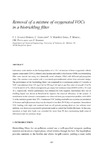Removal of a mixture of oxygenated VOCs in a biotrickling filter

View/
Use this link to cite
http://hdl.handle.net/2183/12836Collections
Metadata
Show full item recordTitle
Removal of a mixture of oxygenated VOCs in a biotrickling filterAuthor(s)
Date
2007Citation
Biotechniques for Air Pollution Control II, 2007: 415-424. ISBN: 978-84-9749-258-4
Abstract
[Abstract] Laboratory scale-studies on the biodegradation of a 1:1:1 wt mixture of three oxygenated volatile organic compounds (VOCs), ethanol, ethyl acetate and methyl-ethyl ketone (MEK) in a biotrickling filter were carried out using two identically sized columns, filled with different polypropylene rings. The reactors were seeded with a two-month preconditioned culture from activated sludge. The performance of the biotrickling filters was examined for a continuous period of 4 months at VOC concentration from 125 mg-C/m3 to 550 mg-C/m3 and at gas flow rates of around 1.0 m3/h, 2.0 m3/h and 4.6 m3/h, which correspond to gas empty bed residence times (EBRT) of 68 s, 33 s and 16 s, respectively. Similar performance was obtained for both supports. Intermittent flow rate of trickling liquid was shown as beneficial to improve the removal efficiency of the system. A stratification in the substrate consumption was observed from gas composition profiles, with MEK % in the emission greater than 78%. Continuous VOC feeding resulted in an excessive accumulation of biomass and high pressure drop was developed in less than 20-30 days of operation. Intermittent VOC loading with night and weekend feed cut-off periods passing dried air, but without water addition, was shown as a successful operational mode to control the biofilm thickness. In this case, operation at high inlet loads was extended for more than 50 days maintaining high removal efficiencies and low pressure drops.
ISBN
978-84-9749-258-4





